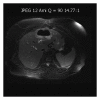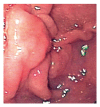Hepatic abscess induced by foreign body: case report and literature review
- PMID: 17457985
- PMCID: PMC4146938
- DOI: 10.3748/wjg.v13.i9.1466
Hepatic abscess induced by foreign body: case report and literature review
Abstract
Hepatic abscess due to perforation of the gastrointestinal tract caused by ingested foreign bodies is uncommon. Pre-operative diagnosis is difficult as patients are often unaware of the foreign body ingestion and symptoms and imagiology are usually non-specific. The authors report a case of 62-year-old woman who was admitted with fever and abdominal pain. Further investigation revealed hepatic abscess, without resolution despite antibiotic therapy. A liver abscess resulting from perforation and intra-hepatic migration of a bone coming from the pilorum was diagnosed by surgery. The literature concerning foreign body-induced perforation of the gastrointestinal tract complicated by liver abscess is reviewed.
Figures





References
-
- Kanazawa S, Ishigaki K, Miyake T, Ishida A, Tabuchi A, Tanemoto K, Tsunoda T. A granulomatous liver abscess which developed after a toothpick penetrated the gastrointestinal tract: report of a case. Surg Today. 2003;33:312–314. - PubMed
-
- Cheung YC, Ng SH, Tan CF, Ng KK, Wan YL. Hepatic inflammatory mass secondary to toothpick perforation of the stomach: triphasic CT appearances. Clin Imaging. 2000;24:93–95. - PubMed
-
- Broome CJ, Peck RJ. Hepatic abscess complicating foreign body perforation of the gastric antrum: an ultrasound diagnosis. Clin Radiol. 2000;55:242–243. - PubMed
-
- Horii K, Yamazaki O, Matsuyama M, Higaki I, Kawai S, Sakaue Y. Successful treatment of a hepatic abscess that formed secondary to fish bone penetration by percutaneous transhepatic removal of the foreign body: report of a case. Surg Today. 1999;29:922–926. - PubMed
Publication types
MeSH terms
LinkOut - more resources
Full Text Sources

